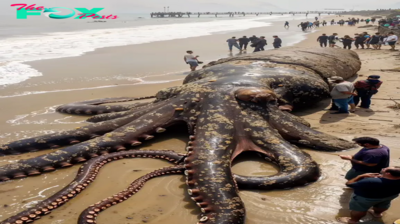Mysterious
ST “Delving into the Abundance of Marine Life: Submerge Yourself in the Realm of Aquatic Variety with 50 Intriguing Fish Species Unveiled, Enhanced with Imagery and Information!” ST
Different species of fish can be found in every body of water around the world. What might be commonplace for you is an exotic and beautiful creature to someone else. In the scope of an article, it would be impossible to document every kind of fish there is. Instead, we’ll focus on a selection of the most interesting fifty types of fish and their unique attributes.

<a href="#"><img style="https://outforia.com/wp-content/uploads/2022/09/Types-of-fish-infographics-09082022.jpg"></a><br>Types of fish Infographic by <a href="#">Outforia</a>You May Also Like: 20 Most Important Fish In Lake Michigan: Native And Introduced
50 Different Types of Fish – Freshwater and Saltwater
1. Barracuda
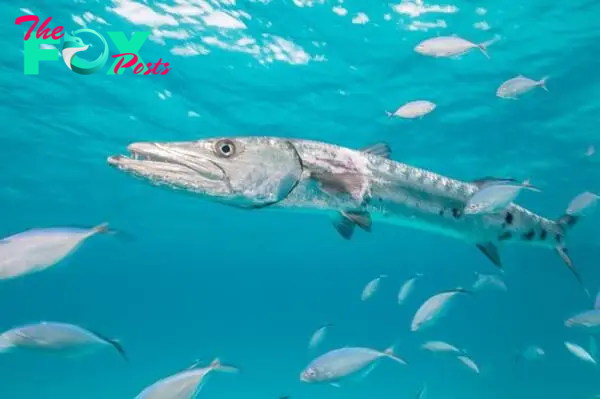
Barracuda are long, snakelike fish. Their mouths are full of large, needle-like teeth. The teeth fit into holes in the opposite jaw, letting them fully close their mouth. When they hunt, they either swallow prey whole or cut it in half with their sharp teeth.
You can find barracuda in tropical waters around the world. They tend to hang around structures like reefs or manmade platforms like oil rigs.
Barracuda are popular fish for sport fishermen because of how well they fight. It’s generally recommended that people don’t eat barracuda. They contain some of the highest known levels of ciguatoxin of any fish. Infected fish aren’t harmed, but the poison is dangerous for humans.
2. Bass

Bass are the most popular target species of fishermen in North America. The name bass refers to both freshwater and marine species of fish belonging to the order Perciformes.
Most members of the bass family have large mouths for gulping down prey. They’re found throughout freshwater lakes, rivers, and ponds. Some marine species exist, but seabass are a group we’ll discuss later.
Bass grow very quickly and have voracious appetites. Given enough food, bass can reach adult sizes of close to two pounds in under a year.
3. Snapper

Snappers are a group of fish containing over 100 species. They are large, schooling fish found in saltwater environments. They also tend to congregate around sunken structures, from reefs to dock pilings.
These marine fish feed primarily on smaller, fish, crustaceans, and mollusks.
Snappers tend to have firm, light-tasting flesh. This has made them a prized commodity in seafood markets around the world. Unfortunately, overfishing has led to severe population declines over the years. As such, many snapper fisheries are stringently regulated to allow them to try to rebound.
4. Bluefish (Pomatomus saltatrix)

Bluefish get their name from their blue skin. If you cut one open, the meat has a blue tinge to it as well. They’re a widely distributed fish, found everywhere except for the Northern Pacific Ocean. In Australia, these fish are called “tailors.”
A single row of short, sharp teeth is the bluefish’s main weapon against prey. Schools of bluefish patrol coastlines in search of large schools of smaller baitfish. They’re fast, strong, and always hungry. This makes them an excellent game fish.
Bluefish tend to grow larger in colder waters. The smaller ones typically only weigh a pound or two. The bluefish in northern waters can reach weights of around 40 lb (18 kg).
5. Trout
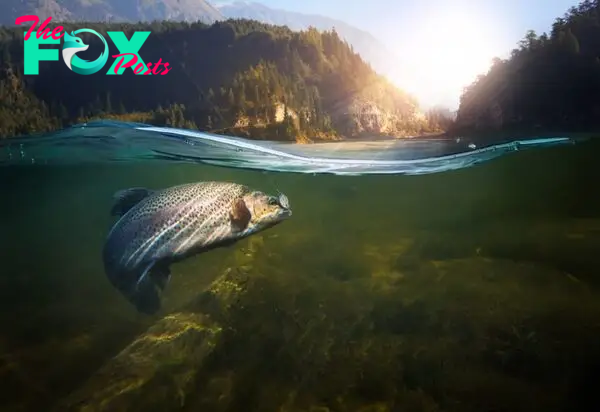
Trout are some of the most adaptable fish in the world. Many species spend time in saltwater, then move to freshwater to spawn. Some saltwater species have adapted to freshwater environments completely.
Trout are big in sportfishing circles. Species from around the world have been introduced to waterways in North America, South America, Europe, Asia, and Africa in the name of fishing.
Some trout are so rare they’re only found in a few select streams. Many of the Animals called trout aren’t actually trout at all. Rather, they are some sort of closely related fish like salmon or char. Many species and types of trout exist, all with their own unique appearance and behaviors.
6. Bullhead

Bullheads are a group of catfish with squared tails. There are several species of bullheads, which are closely related to channel catfish. Most of the time, bullheads don’t grow larger than 12 inches (30 cm) in length.
Slow-moving water is their favorite habitat. They make their home in slow streams or rivers, as well as in ponds and lakes.
Bullheads are bottom-feeders. Most of their diet is made up of insects, plants, and worms. They also feed on small fish, snails, and carrion.
7. Carp
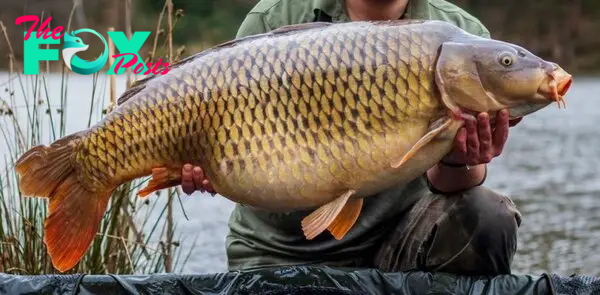
Carp are freshwater fish native to Europe and Asia. In North America, Africa, and Australia, they’re considered invasive species. They have small, downward-facing mouths. Carp are omnivores, eating plants, plankton, worms, and insects.
Carp are unique because some species can survive with almost no oxygen for months. They survive in banks of mud or under ice until conditions get better.
Goldfish and koi are both types of carp. These are valued for their appearance and make great pets.
8. Catfish
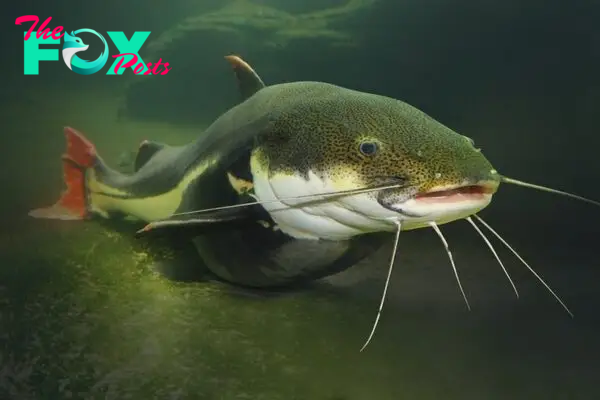
Catfish get their name from the barbels on their face. Those barbels look like whiskers, and like whiskers, are very sensitive. They help catfish sense vibrations in low visibility water.
Many different species make up what we call catfish. They’re found on every continent except Antarctica and some even live in the ocean. Their sizes depend on how much food is available and their species. Some may grow to only a few inches and weigh under two pounds. Others can grow to weigh half a ton.
Catfish are voracious eaters that tend to eat anything they can regardless of their species. Some are ambush predators, gulping down fish that pass too near them. Others are opportunists, scavenging carrion and human waste.
Be careful if you handle a catfish. Most types of catfish have spines in their pectoral and dorsal fins. Those spines can deliver a painful, yet not deadly, poison.
9. Mackerel
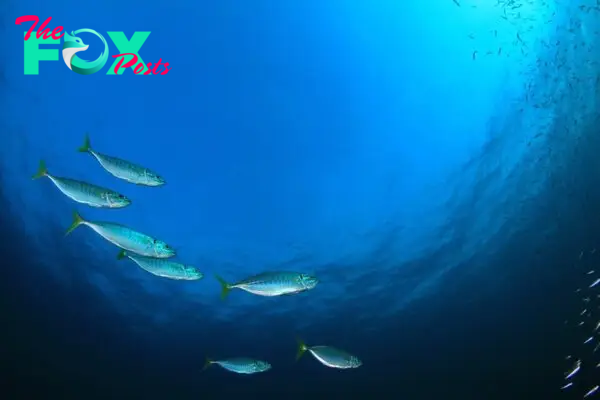
Mackerel is the common name that gets used for several species of small, open-water fish. Most of them have deeply forked tails and some form of stripes. They’re one of the most important fish in the ocean because they serve as food for every larger fish around.
Some mackerel species grow larger than their fodder cousins. King mackerel, on average, grow to weigh between 5 kg (11 lb) to 14 kg (30 lb). The largest member of the mackerel family, the wahoo, can weigh up to 83 kg (183 lb).
Small mackerel is one of the most populous fish in the ocean. The Health of those populations is what keeps most of the food chain intact. Without them, we wouldn’t have sharks, dolphins, or larger fish that we usually prefer to eat.
10. Clownfish

Clownfish were always a popular aquarium pet, but they were made even more famous by the film Finding Nemo. Their populations have suffered because of the devastation of coral reefs and their capture for the aquarium trade.
There are actually 30 species of clownfish, they aren’t just one species. Most are orange with black bars or white spots. Aquarists have bred different color patterns and species through selective breeding programs.
Clownfish have a special adaptation that allows them to not be hurt by stinging anemones. They live in a symbiotic relationship with the anemones. The polyp protects the clownfish while the clownfish use its bright colors to lure smaller fish for the anemone to feed on.
Clownfish are also hermaphrodites. All clownfish are born male, but some will become females. Once they switch, they can not go back to being males. They live in groups of male fish, with a dominant male and a dominant female. If the female dies, the dominant male turns female.
11. Cod
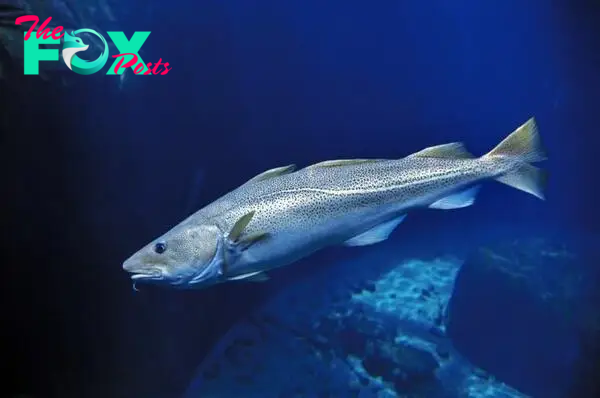
Cod is a group of coldwater fish found primarily in northern waters. They’re incredibly common and have been used for all sorts of products. The most common fish used in the English dish fish and chips is Atlantic cod.
Cod are a popular food because they have a very mild flavor that isn’t too fishy. They have also been used to make cod oil. Cod oil is a vitamin supplement that contains Vitamin A, Vitamin D, Vitamin E, and plenty of omega acids.
Because of their popularity as food, cod fisheries have collapsed multiple times in history. This led to many fish that were unrelated to cod being dubbed “X cod” and sold as cod substitutes. True cod include Atlantic cod, Pacific cod, Greenland cod, and Alaskan Pollock.
12. Eels

Around the world, there are around 800 species of eels. They’re generally sorted into 19 families that you can read more about here.
For a long time, we didn’t know anything about eel reproduction. Eventually, we discovered that all eels, whether fresh or salt water, went to specific areas in the sea to spawn. At least, as long as they weren’t completely landlocked.
Eels are a staple food in many parts of the world. Northern Europe is famous for eel dishes, while Japan and other parts of the world use them in sushi.
You can find eels in every part of the ocean and in many freshwater rivers. Electric eels though aren’t actually eels. It’s a common misconception, but electric eels are a type of knife fish.
13. Sharks

Sharks are one of the top predators in the ocean. Very few other animals hunt sharks. They can range in size from only a few inches to nearly 40 feet (12 meters) in length. Sharks live in the open ocean, along coastlines, and even in the deepest parts of the sea.
A few sharks, like the bull shark, have the ability to enter freshwater. Bull sharks have been found thousands of miles from the ocean in both the Mississippi and Amazon River systems.
Sharks serve as population control for their prey. They hunt smaller fish, squid, marine mammals, and even turtles. A healthy shark population is one of the best indicators of a healthy fishery.
Sharks have extra sensing organs in their snouts that fish don’t have. These are small nerves called the ampullae of Lorenzini and they sense the small electrical pulses that are generated by all living organisms.
14. Dogfish

Dogfish are a group of small sharks that live in coastal waters and hunt in packs. Sometimes they can number in the thousands, chasing squid and small fish along the bottom. Unfortunately, this pack-hunter behavior makes it easy to overfish them.
Most species are endangered or threatened, despite being incredibly numerous just a few years ago. They’re a popular food in Europe and have been devastated by the shark finning trade that supplies shark fin soup to China.
Dogfish, despite living near coastlines, are deepwater sharks. They generally spend their time at around 50–149 m (160–490 ft) but have been found well over 700 m (2,300 ft) deep.
15. Flatfish

Flounder, turbot, and halibut are all different types of flatfish. They’re all rounded, flat-bodied fish that spend much of their time on the seafloor. The colder their environment, the larger they grow.
Many flatfish are considered excellent table fare.
Flatfish are both peculiar and unique. At birth, they appear like normal fish. As they mature, they eventually turn to one side and their eyes begin to migrate to the top side. Their coloration also changes to be white on the bottom and darker on top. That isn’t all though, their entire body structure changes to adapt to their new way of life.
They then live the rest of their lives lying on the sea floor like door mats, waiting for prey to swim overhead or chasing it down.
16. Grouper
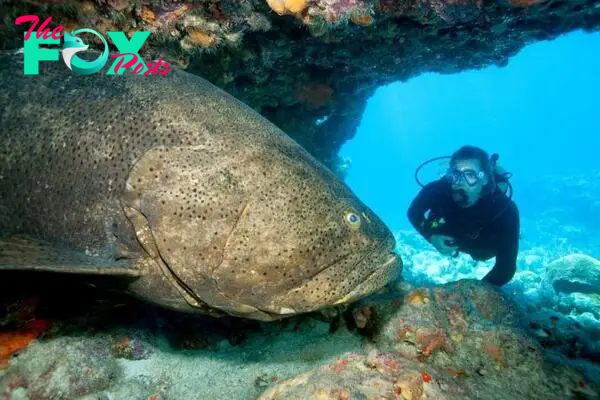
Grouper are medium to large marine fish that are related to the freshwater species of bass. All of the members of this group have huge mouths and thick, stout bodies. Some may only be around a foot (half a meter) in length, while the largest species can weigh over a ton.
Most grouper are ambush predators. They sit on the bottom or in rocky holes and use camouflage to lie in wait. When they open their mouths, it creates a vacuum of water that sucks in prey.
There are over 200 different species of grouper around the world. Most are considered excellent table fare and are prized in the seafood industry.
A few species, like the goliath grouper, faced massive overfishing due to their huge size. These are protected and have begun rebounding in recent years.
17. Lionfish
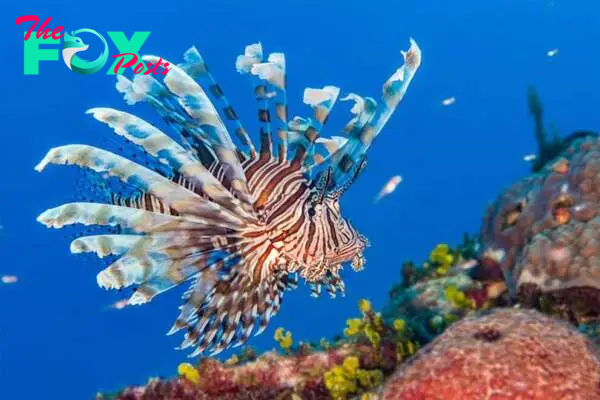
Lionfish are a beautiful and potentially painful fish to share the water with. Most lionfish have frilly fins and a tiger-stripe body pattern. They seem to float through the water with incredible grace.
Because they’re so slow and brightly colored, they rely on their fins to hypnotize their prey. They slowly glide up and inhale small fish.
Hidden behind their pretty fins are sharp, venomous spines. While not deadly to humans, the extreme pain can last days and is accompanied by swelling, sweating, trouble breathing, and sometimes paralysis.
Lionfish are native to the Pacific Ocean but have spread to other oceans thanks to their popularity as aquarium fish. Once released, they have wreaked havoc on fisheries in the Atlantic Ocean and Gulf of Mexico.
18. Marlin
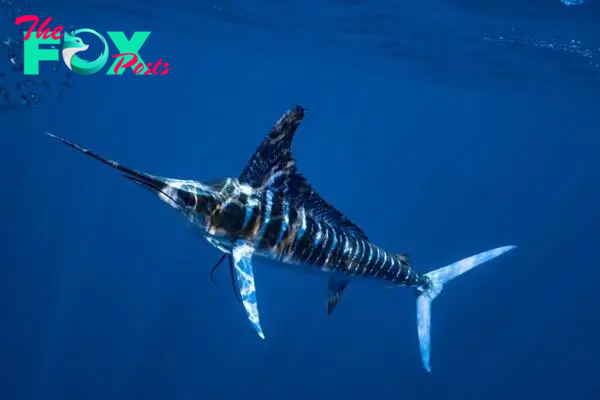
Marlin is a group of fish that include around ten different species. They’re best known for their long, sword-like bills. All marlin are open-ocean predators. Their elongated bodies and powerful muscles make them some of the fastest fish in the ocean.
The black marlin and blue marlin are the best-known species. They can both reach lengths of around 5 m (16 ft) and can weigh as much as 670 kg (1,480 lb).
Their reputation mainly comes from their sportfishing popularity. They’re huge fish that put up a fierce fight when hooked. Some marlin catches can take well over six hours from the time they’re hooked until the time they’re caught.
Due to overfishing, most marlin species are considered endangered. Fishing tournaments have changed to a catch-and-release system to help protect the fish.
19. Perch
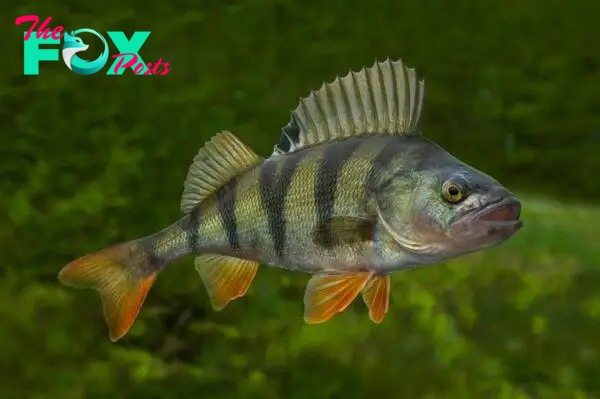
Perch is the common name for a group of freshwater fish. While perch is the name used for a number of fish, there are only three species of perch. The European, Balkhash, and Yellow Perch make up this group of fish.
Perch prefer shallow, calm water. You can find them most often in ponds, lakes, and slow streams.
Though fairly small, perch are a popular sportfish. They fight well and are considered good eating.
20. Pike
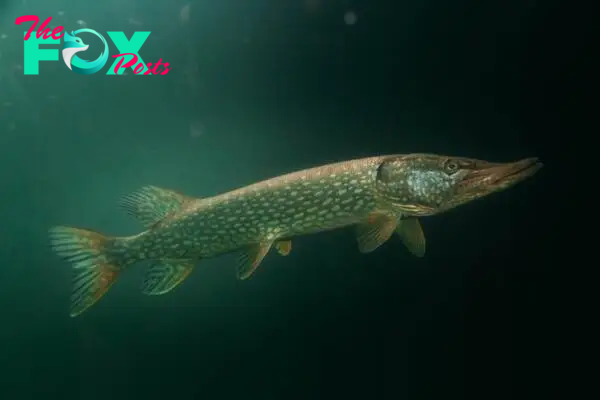
Pike are the apex predators of freshwater lakes and rivers. They have long, cylindrical bodies and needle-like teeth. The most common spots for pike to hide are in grass beds where they can ambush small fish.
Pike as a group includes the northern pike, muskellunge, and pickerel. Northern pike and muskellunge can grow to over a meter in length. Once this large, everything from birds and maMMAls to large fish is potential prey for them.
Pike are mainly found in the northern waters of North America and Europe. Aside from sturgeon, they’re some of the largest freshwater fish you can find in these areas. Their size, voracious appetite, and strength make them prime fishing targets for anglers.
21. Stingrays

Stingrays are a large group of flat-bodies rays that get their name from the spine at the base of their tail. The spine is coated in a potent venom and is mainly used for self-defense against predators.
Rays are closely related to sharks. They have rounded flat bodies. Their tail is thin and resembles a whip. The spine on their tail is shaped like a spear point and sits slightly above the base of the tail.
Stingrays can swim well enough but spend much of their time buried on the bottom. Their mouths are on the underside of their body. This lets them feed on fish and other crustaceans. Instead of teeth, they have crushing plates in their mouths.
Different species of stingrays can be found in both salt and fresh water. Some species are around the size of a pancake, while others can grow to monstrous proportions. I’ve even caught Atlantic stingrays that were well over six feet (two meters) across.
22. Salmon

Salmon make a very unique journey during their lifetime. They spawn in freshwater rivers but spend most of their lives in the open ocean. When it’s time to spawn, they head to the river they were born in. They fight against the current to their spawning grounds, spawn, and then die.
Salmon spawning season plays a vital role in every ecosystem they can be found in. Their upriver migration provides food for hundreds of species, including humans.
During the migration, they change drastically. Their mouth turns upwards into a hook shape and their color pattern changes from silver to pink.
Unfortunately, salmon populations face a lot of problems. The largest of them is the damming and obstruction of rivers by people. Instead of spawning, many get stuck and just die. Salmon chutes have helped alleviate this pressure.
23. Seabass
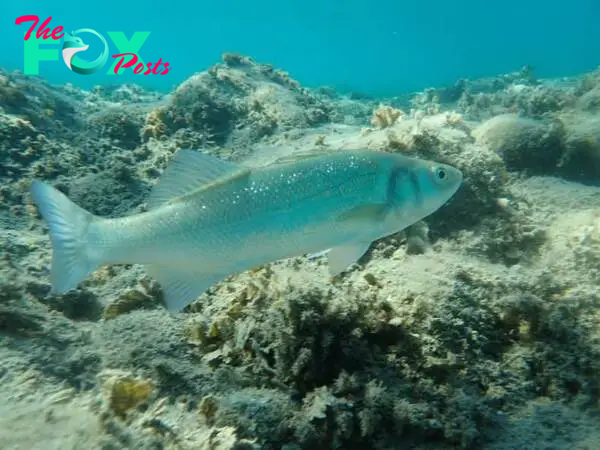
Seabass is a common name for several species of fish that all resemble grouper and freshwater bass. The black sea bass is one of the true members of the family. Sea bass is generally considered to be part of the Serranidae family.
Types of cod, grouper, and marine “perch” have all been called seabass.
In total there are around 475 species that are considered sea bass. They all have perch-like bodies. This means small scales, large mouths, and slightly elongated but stocky body shapes.
24. Herring
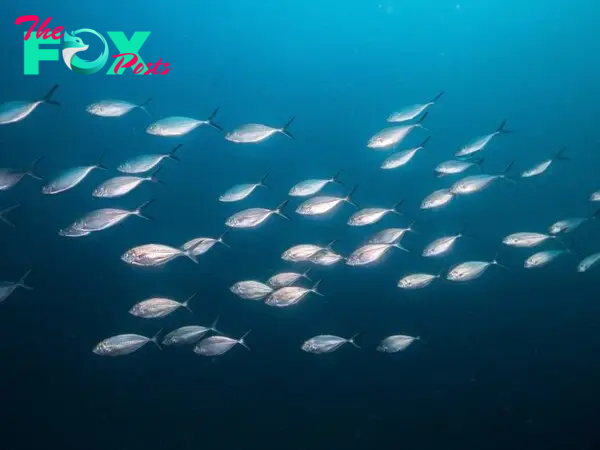
Herring is a common name that refers to many types of forage fish. The larger group includes menhaden, shads, herrings, and sardines. Most members of the group have thin, elongated bodies and v-shapes tails.
Generally, herring refers to one of two types of fish. Either the Clupeus harengus or the Clupeus pallasi.
The first of these is the fish you think of when you think of sardines. The younger state of this species is the fish you find in a can of sardines. These are found in the northern Atlantic Ocean.
The second of these is harvested for its roe. They’re found in northern Pacific waters.
These fish are important for marine ecosystems because they provide the prey for most of the larger fish we are more familiar with.
25. Shad
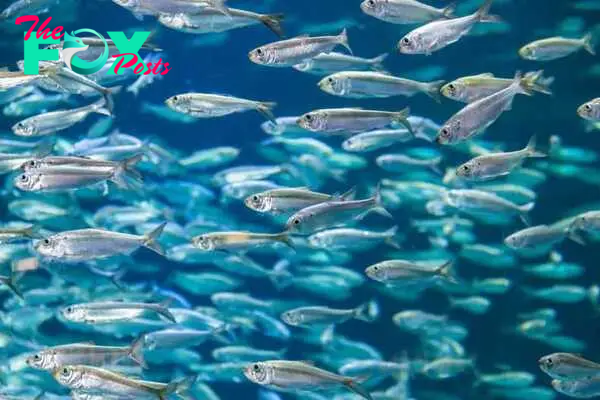
Like herring, shad is a common name that can refer to any number of small baitfish. Most commonly, shad refers to small, silver fish found in freshwater rivers of North America.
The American shad has a hatchet-shaped body It can grow to weigh between 3 and 8 pounds (1.5 and 3.5 kg), but is mostly seen much smaller. American shad played a major role as a food source for early colonizers of North America.
These fish spend most of their time in the ocean but spawn in freshwater. Huge schools of juvenile shad jump and ripple through the water as they migrate together. Most of their diet consists of plankton, but shrimp and tiny fish are also food for them.
26. Skate
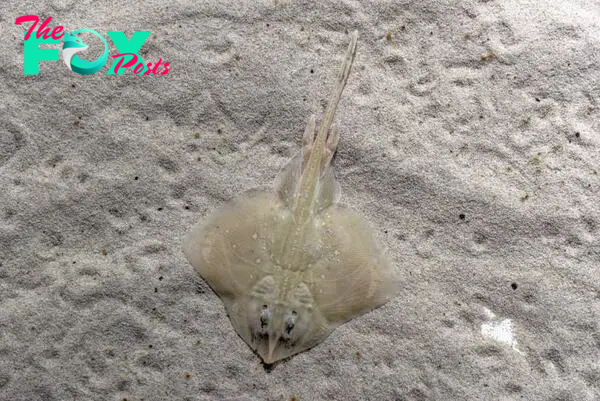
Skates are very closely related to rays. They’re another flat-bodies group of fish that can be found all over the world at any depth. Skates stand out from stingrays because of their shovel-like, see-through noses.
Skates have a slow-reproductive cycle and grow slowly. This makes them extremely vulnerable to overfishing and population declines.
Their body can be rounded or diamond-shaped. Like rays, they swim by moving their “wings” which are body protrusions on their sides. These wings are the edible part of the animal and why they do get harvested for food.
27. Snook

There are twelve species of snook and five of them can be found in Florida waters. They can grow to be over 40 pounds (18 kg). Snook are very popular sportfish in all their native ranges. They’re incredible fights and have tasty white flesh.
Handling snook can be hazardous. You have to lift them by their mouths because their gill plates are razor sharp. Picking one up by the gills is a sure way to end up needing stitches.
While snook are marine fish, they can tolerate a wide range of salinity. This means they can go up rivers and spend a lot of time in brackish water. Their favorite habitats are around mangrove swamps where their young can hide in the roots.
Despite their tolerance for saltiness, they have trouble with temperature changes. Snook populations took a huge hit in Florida in 2010 because of a cold snap.
28. Sturgeon
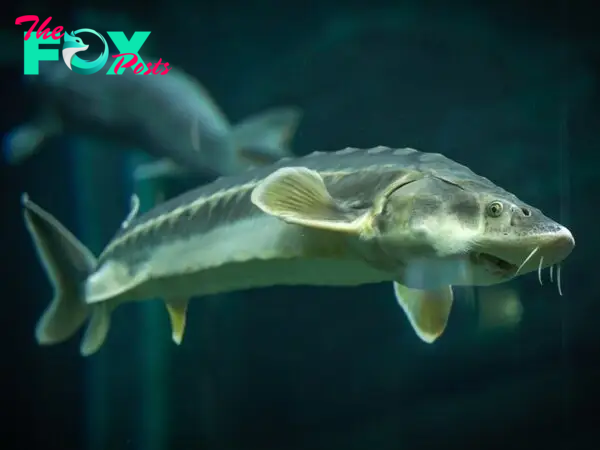
Sturgeon are ancient, massive, and surprisingly docile fish. They’re one of the few fish that have bony plates of armor on their body instead of scales. 27 species of sturgeon are known worldwide. Their identity in the fossil record dates back as far as the Jurassic period.
Sturgeon grow slowly and take a long time to mature. Adults of most species can reach lengths of around 2–3.5 m (7–12 ft).
Despite their size, sturgeon are calm Animals. They move slowly and have very small mouths. The mouth faces down, which is perfect for feeding on worms and small fish along the bottom. They also have no teeth, relying on suction and swallowing prey.
Most species of sturgeon are endangered. This is mainly because their roe is processed into very expensive luxury caviar. Unfortunately, the roe can’t be harvested without killing the fish in most cases.
Combined with their slow growth rate, sturgeon are in serious danger of becoming extinct within our lifetimes.
29. Sunfish
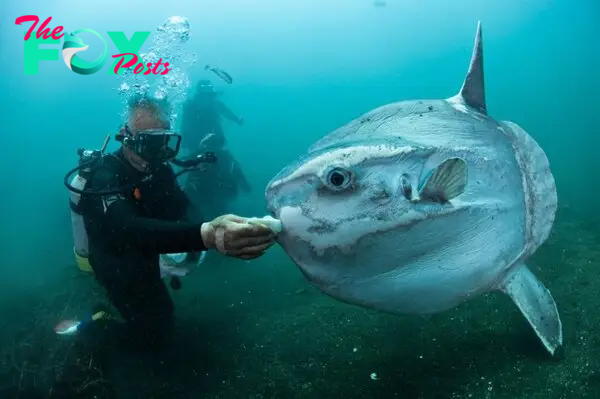
Freshwater sunfish include a large number of species. These include bluegill, bass, and crappie. Most of them are or will be covered elsewhere in the article, so we’re going to discuss the ocean sunfish instead.
Ocean sunfish (also called Mola Mola) are huge, weird fish. They’re the heaviest bony fish in the world, with adults weighing in between 247 and 2,000 kg (545 and 4,409 lb).
They can be as long as they are tall. Instead of a tail, they have flaps on their rear and long fins on their tops and bottom.
Sunfish get their name because they sun themselves. They’re commonly seen presenting one of their broad sides towards the sun near the surface. It’s thought this is their way of warming up after going for a deep dive to feed.
Their diet includes small fish, crustaceans, squid, and jellyfish. They pose no significant threat to humans. While capable of swimming and launching themselves from the water, they mostly drift along in ocean currents.
30. Swordfish

Swordfish may look a lot like marlin, but they’re only related. Swordfish are actually the only species in their scientific family. They have a long, flat bill and commonly reach over ten feet (3 meters) in length.
By day, swordfish spend their time very deep. They have special organs that heat their eyes and brains. Speaking of their eyes, their eyes are huge. It helps them see in the inky black deep ocean.
Longline fishing desperately hurt swordfish populations, but their capture this way has mainly been banned. They have since recovered and are back to being a popular seafood choice in areas that can find it fresh.
31. Tilapia

Tilapia is the common name for several species of fast-growing cichlids. Tilapia is a native species of Africa, inhabiting freshwater environments. They’ve grown in popularity because of their fast growth rate and because they’re easy to farm.
Overfishing is a large problem in our oceans and rivers. Unfortunately, fish populations can’t keep up with human demand. One solution for this is fish farming. Instead of removing fish from the natural populations, grow them ourselves.
Not all fish do well in farms though. Tilapia is one of the few species groups that are easy to farm, grow fast, and breed fast. This makes them very popular on fish farms to produce fish for human consumption.
Tilapia are an invasive species throughout much of the world. Releases from farms have led to their introduction to many waterways in North America, Europe, and Asia.
32. Tuna
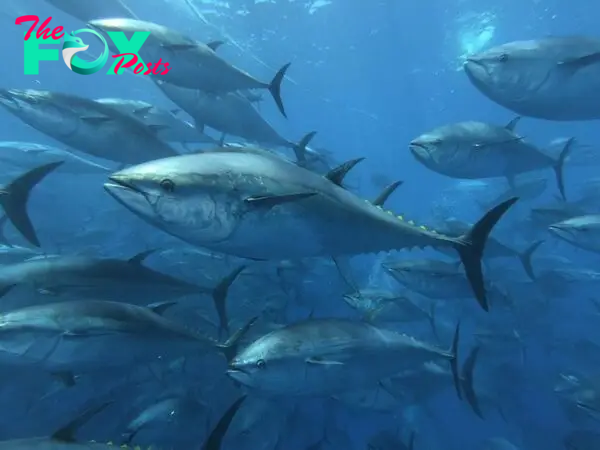
Tuna are a group of 15 different species of saltwater fish. This group is one of the few fish that maintain a higher body temperature than the water around them. They have this ability because of their muscular bodies and constant motion.
Tuna are fast, streamlined fish. Most have bodies shaped kind of like footballs and are incredibly strong. Small tuna can be as small as 50 cm or 1.6 ft. The largest though, the Atlantic Bluefin tuna, can grow as large as 4.6 m or 15 ft. These fish can weigh up to 684 kg or 1,508 lb.
Tuna is an important food fish for humans. The packaged tuna at the store is usually albacore tuna, a medium-sized fish. Larger tuna are prized as a staple in different kinds of sushi. Some bluefin tuna can sell for hundreds of dollars per pound.
33. Whitefish

Whitefish aren’t any specific fish at all. Whitefish is just a term that refers to any kind of fish that has white, flaky flesh when cooked. They’re some of the most popular food fish for humans because they tend to have a milder taste than other species. If you don’t like fishy-tasting fish, then these are for you.
34. Seahorse
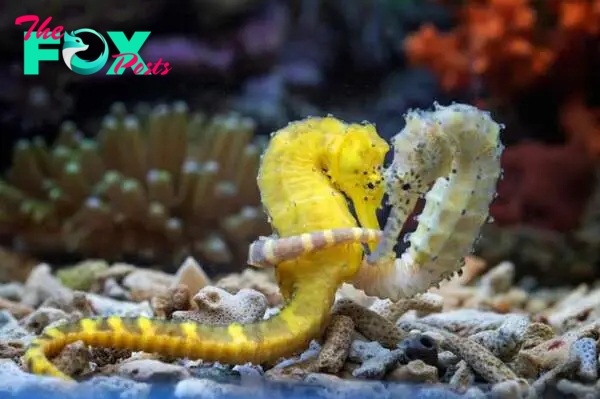
Seahorses get their name from their unique anatomy. They have heads that sort of resemble a horse’s. Small fins on their backs help propel them through the water. Instead of a finned, tail, seahorses have a long, grasping type of tail. They use it to hold on to corals, plants, or rocks to anchor them in place.
Seahorses are ocean-dwelling fish. Around 50 species can be found around the world. Generally, seahorses are found in tropical and warm waters around corals and large grass beds.
Perhaps the most unique thing about seahorses is that the male gives birth instead of the female. Male seahorses have a pouch on their stomach that the female deposits eggs into. They carry the eggs until they hatch and then release the baby seahorses into the water.
35. Wrasse
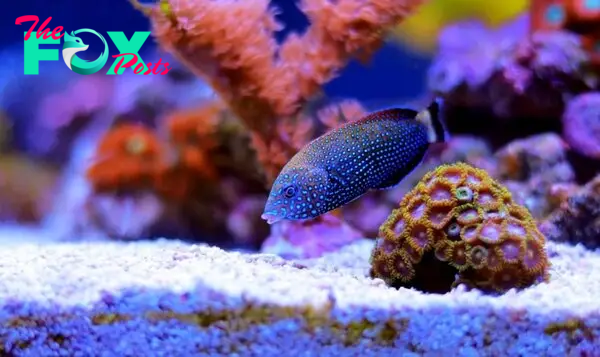
Wrasses are fish that belong to a huge family of related species. These marine fish include over 600 different fish. Most of them are small, only reaching a few inches in length. The largest though can be over eight feet (2.5 meters).
Perhaps the coolest kind of wrasse is the cleaner wrasse. These fish inhabit coral reefs and other structures on the seafloor. Instead of hiding from larger fish, they help them.
Cleaner wrasse eats parasites and dead tissue off of larger fish. Instead of eating the cleaner wrasse, larger fish go to “cleaning stations” and allow the smaller fish to clean them of parasites. They even swim into the mouths and gills of other fish to clean them.
This is one of the coolest examples of beneficial behavior and cooperation between fish species.
36. Rainbowfish

Rainbowfish are a group of colorful freshwater fish that are popular in home aquariums. Most of them prefer to live in schools and play well with other fish. They’re best known for their striking color palettes.
In the wild, rainbowfish prefer areas with dense vegetation. It allows them to feed and hide from larger fish that would prey on them. Swamps, marshes, rivers, and ponds are all ideal habitats for them.
37. Guppies
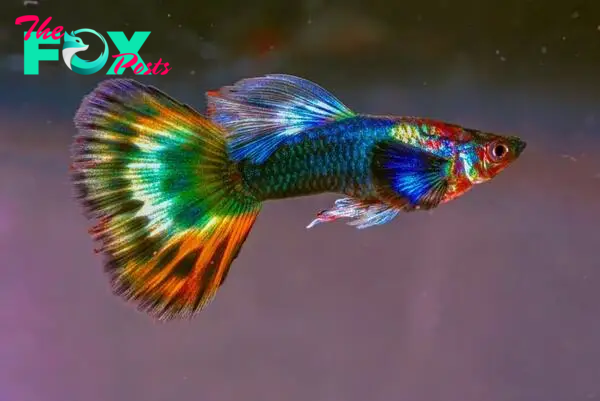
Guppies fit into the rainbowfish family. They tend to have flowing, wide tails and rounded bodies. Originally, guppies were found in South America and parts of the Caribbean. These tiny freshwater fish are popular in aquariums and have been bred to have vibrant colors.
Because of captive breeding, there isn’t really a singular species for guppies. They’re selectively bred to be sold for home aquariums. Most guppies only reach a length of a couple of inches (four or five centimeters) and can live between two and three years.
38. Goldfish

Goldfish in the wild are a type of brightly-colored carp. Their native range in is eastern Asia. Goldfish are very popular as pets, which has led to a diverse range of sizes and color patterns. Most of the time, they’re selectively bred to create new, exciting kinds of goldfish.
Around most of the world, goldfish are considered an invasive species. They breed quickly and grow based on how much food and space is available. Flushing goldfish and releasing them into the wild has led to huge specimens being found in waterways.
There is a myth that goldfish have tiny brains and basically no memory. This is completely false, their memory can go back for months at a time. They also are quick learners. They can be trained to do tasks and associate what they see with things like food.
39. Anchovies
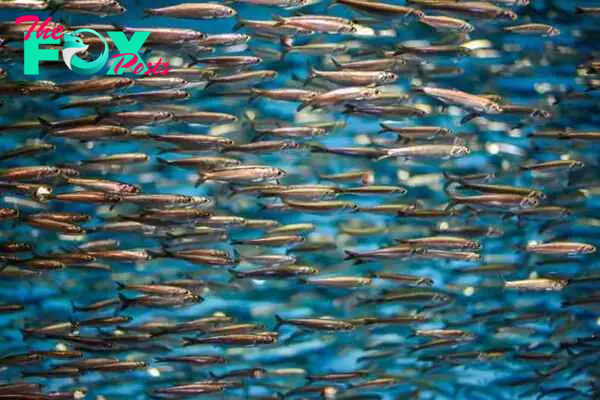
Anchovies are another one of those fish that are more of a group of fish than any one in particular. Over 100 species of forage fish are in the anchovy group. They’re mostly saltwater fish, but some can tolerate brackish water. One group in South America is exclusively a freshwater fish.
Most anchovies are small, green fish. They have oily flesh and were caught historically to produce fish oil. Anchovies mass in huge schools and feed primarily on food particles and plankton in the water.
40. Angelfish
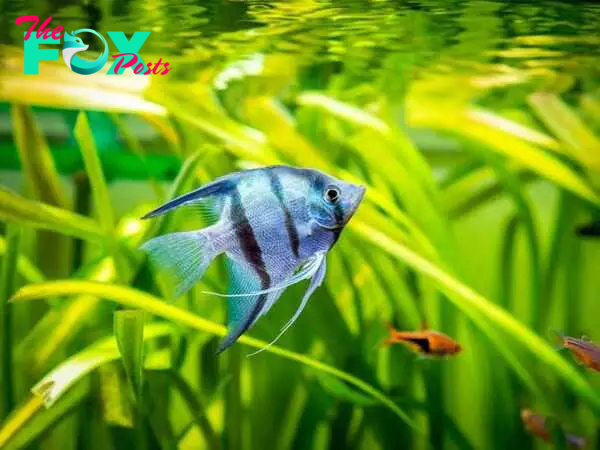
Angelfish are a small group of freshwater fish native to South America. All three species of angelfish have elongated dorsal and anal fins that resemble wings. These angel wings are what give them their name.
Their body shape helps them hide in roots and around grasses. They prey on smaller fish and invertebrates.
All angelfish form monogamous breeding pairs. They carefully care for and protect their eggs together. This care even extends after the eggs hatch, as they watch over the baby fish.
Angelfish have been bred in captivity to create unique colors and sizes for home aquariums.
41. Beta Fish

Beta fish are gorgeous little fish that are native to Asia. They’re fiercely territorial, leading to their name as fighting fish. In the wild, they stake a claim on a small area of their pond or river and defend it with their lives.
Oddly, there isn’t too much fighting between beta fish in the wild. As long as the number of fish in an area is small enough, they don’t even need to fight for territory. Male betas are the ones that fight though. Females can be kept in groups or community aquariums.
Generally, they only need a small amount of space in captivity. Fighting occurs between fish stuck in too small a space. While pet stores sell them in tiny cups, bettas need much more space than this to thrive.
Due to their popularity as pets, exciting color patterns and body types have been bred into betta fish.
42. Tetras
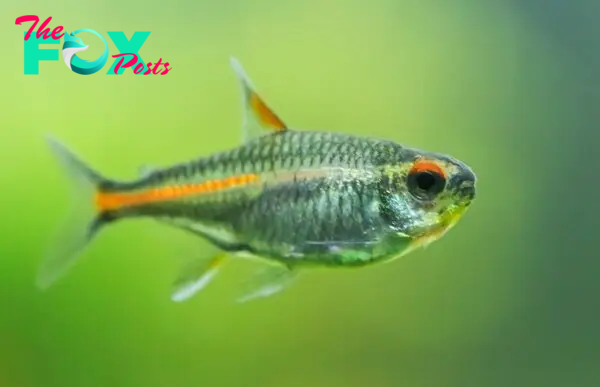
Tetras are a group of small, schooling, freshwater fish. Most don’t reach a length of over an inch (2.5 cm). This group of fish species originated in both South America and Africa, though most are now bred in captivity.
Tetras became popular because they’re easy to care for, do well in schools, and have bright colors. There is a massive variety of colors, patterns, and body shapes when it comes to tetras.
Some captive-bred types of tetras have been bred to live under blacklights. These fish legitimately glow in the dark. They’re genetically-modified fish that have been selectively bred. Despite rumors, they aren’t injected to get their glowing appearance.
43. Gobies
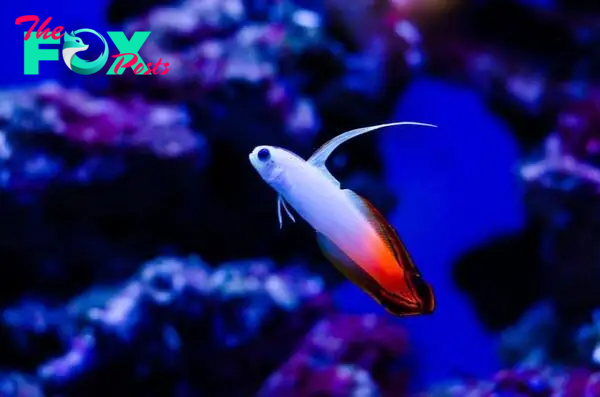
Goby is the common name for a group of fish consisting of over 2,000 species. They tend to be small, carnivorous fish that live on the bottom. They stick there with a weak suction cup formed by their pelvic fins.
Most gobies have elongated bodies and don’t have any scales. Some even have transparent skin. Some can move across land for small distances. These fish live on tidal flats and move between burrows in mud.
44. Piranha
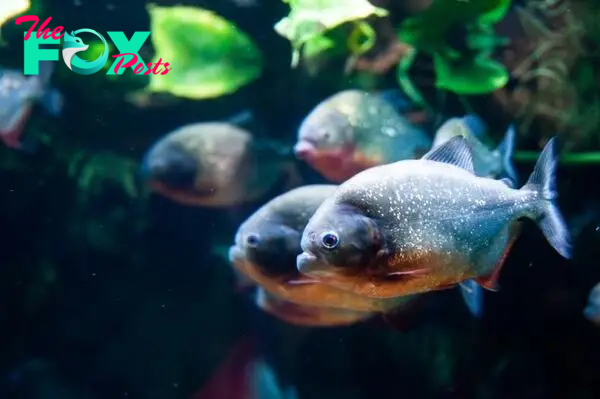
Piranhas may haunt your dreams as vicious fish, but that reputation is very much overrated. There are around 60 species of piranha and all of them inhabit freshwater environments in South America.
Piranhas have razor-sharp rows of teeth and live in large schools, but aren’t usually active hunters. Instead, most of them are scavengers. They feed on dead fish and animals instead of hunting and killing.
Despite their teeth, many species feed on plants, fruit, and seeds. These make up the vast majority of piranha species.
Very few species of piranha grow over 60 cm (2 feet) long. It’s rare for them to hunt, but they can work themselves into a frenzy when they do. Most of the time, they only go after animals slightly larger or the same size as themselves.
45. Tangs

Tangs, or surgeonfish, are a group of colorful reef fish that are popular in aquariums. Dory from Finding Nemo is a blue tang. The movie didn’t help their numbers in the wild, as it made them more popular than ever. Thankfully, captive breeding programs have helped alleviate that pressure.
Around 80 species make up the tang group. They all have bright colors, sharp spines hidden along their body, and can be very territorial. Most of them are fairly small and can act as cleaner fish on reefs.
46. Butterfly Fish
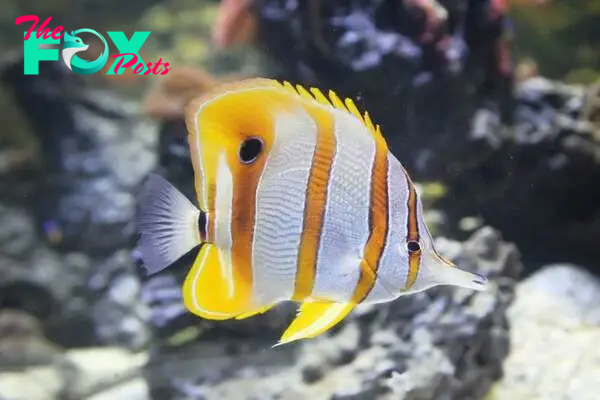
Butterfly fish are a group of tropical reef fish that include well over 100 species. The group is distinguished by their rounded bodies and long snout of a mouth. They have tall but thin bodies and may have long, flowing fins.
Most butterfly fish eat corals and other polyps. They’re also pelagic breeders despite living on reefs. What this means is that they release eggs into the open ocean currents. It floats around and becomes part of the plankton in the water.
47. Damselfish
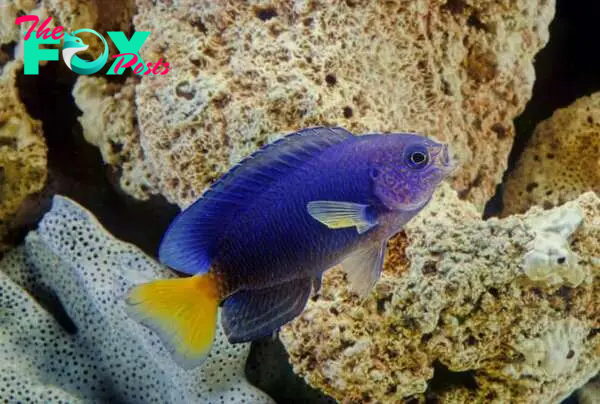
Damselfish are small, bright fish that are incredibly popular for home aquariums. Around 250 species make up the group, with most living in saltwater environments. They’re strong, aggressive, and territorial.
Damselfish feed on algae and other foraged material. Many species spend the vast majority of their time foraging, but some have found a way around it. Instead, those damselfish farm stretches of the reef for algae and promote it’s growth.
Some damselfish have tamed shrimp that they defend and keep as pets. In return, the shrimp helps promote algae growth in the damselfish’s farm.
48. Pufferfish

Pufferfish are some of the most adorable but potentially deadly fish in the world. They can inflate themselves into a ball, contain deadly poison, and have a serious bite. Inside their mouth, puffers have singular super-sharp bones for their upper and lower teeth. It lets them cut easily through soft-bodied prey like squid.
Puffers don’t iNFLate with air, they suck water into a special organ to turn themselves into balloons. When they do this, their spines stretch outwards and their extra size makes them dangerous to eat. They can get stuck in a predator’s throat, choking and killing them.
Puffers can come in a wide variety of shapes and colors. They all have a toxin that makes them taste bad to other fish, but some have more than others. Fugu, a japanese puffer, contains tetrodotoxin which is incredibly deadly.
Most pufferfish live in the ocean, but there are a few species that live in freshwater.
49. Barbs

Barbs are a group of fish that are part of the minnow family. They tend to have bright colors and are lively fish. Both of these make them excellent fish for a home aquarium. Most do best if kept in groups of five fish or more.
Selective breeding has brought out incredible color patterns and even some longer fins. Again, there are more barbs in captive programs than out in the wild. Unfortunately, the widespread nature of the species and their name makes it difficult to get too specific about any kinds of barbs.
50. Killifish
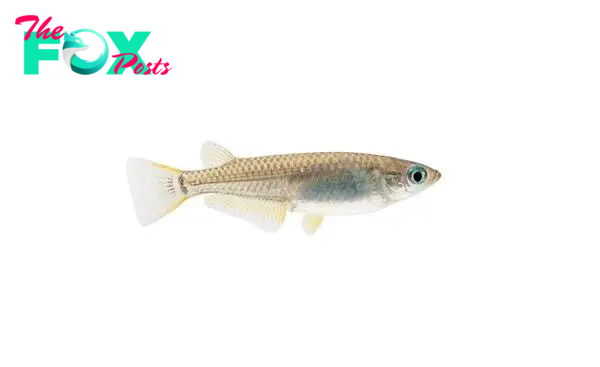
Killifish is a massive group of fish consisting of hundreds of species. Their other name is “top-laying minnow,” because they feed at the surface on anything they can get in their mouths.
Killifish lay eggs, have long fins, and the largest of them only reaches 15 cm (6 inches) in length. The group can be found around the world in every salinity of water.
Some African killifish live in shallow pools that can dry out during the dry season. They lay eggs in the bottom of the pools to protect them. The eggs lay dormant until the pool refills with water. These fish depend entirely on the shallow pool and their lifecycle plays out in the short periods when there is sufficient water to keep them alive.
-

 Mysterious2w ago
Mysterious2w agonht.”Exploring Humanity’s Pursuit of the Legendary 9-Meter, 4-Ton Giant.”
-

 Mysterious2w ago
Mysterious2w agonht.Once-In-A-Lifetime Footage Of A Massive Humpback Whale Leaping Out Of The Water Next To A Fishing Boat
-
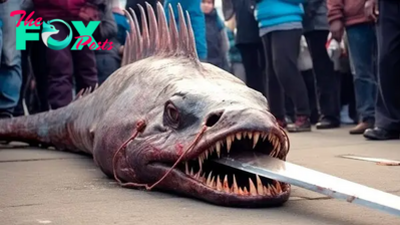
 Mysterious3w ago
Mysterious3w ago.Global Sensation: Mesmerizing Footage of Giant Prehistoric Swordfish Captivates Audiences..D
-

 Mysterious3w ago
Mysterious3w agonht.The discovery of a peculiar creature with human and fish-like features is causing a stir on social media.
-

 Mysterious3w ago
Mysterious3w agonht.Google Maps reveals a possible extraterrestrial portal near Area 51, sparking widespread interest in the UFO community.
-

 Mysterious3w ago
Mysterious3w ago.Heroic Act: Rescuing Live Turtles from Fish Markets and Returning Them to the Ocean..D
-

 Mysterious3w ago
Mysterious3w agoB83.Exploring the Universe: Alien Forms and Their Extraordinary Means of Transportation Revealed
-

 Mysterious3w ago
Mysterious3w agoB83.The Goblin Man: A Remarkable 5,500-Year-Old Mummy and the Secrets of His Preservation








